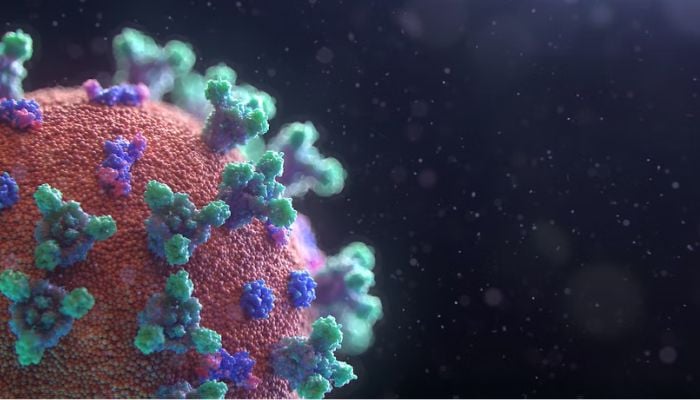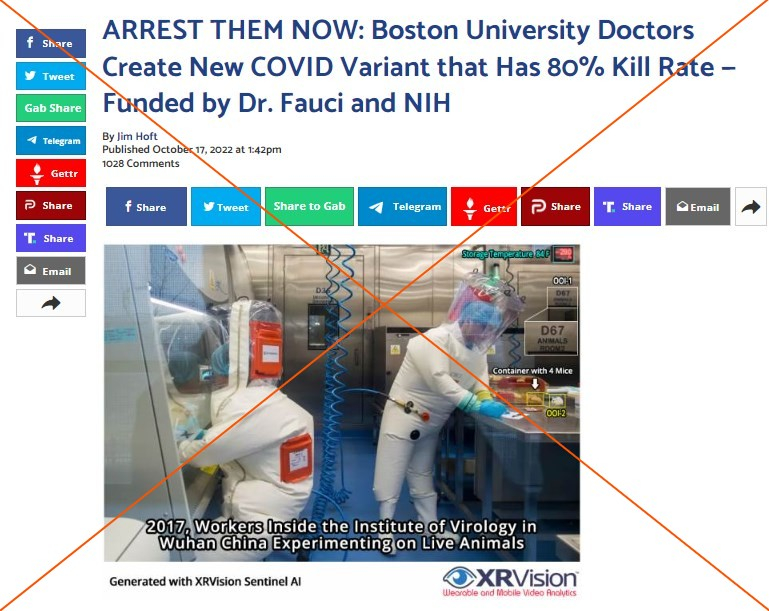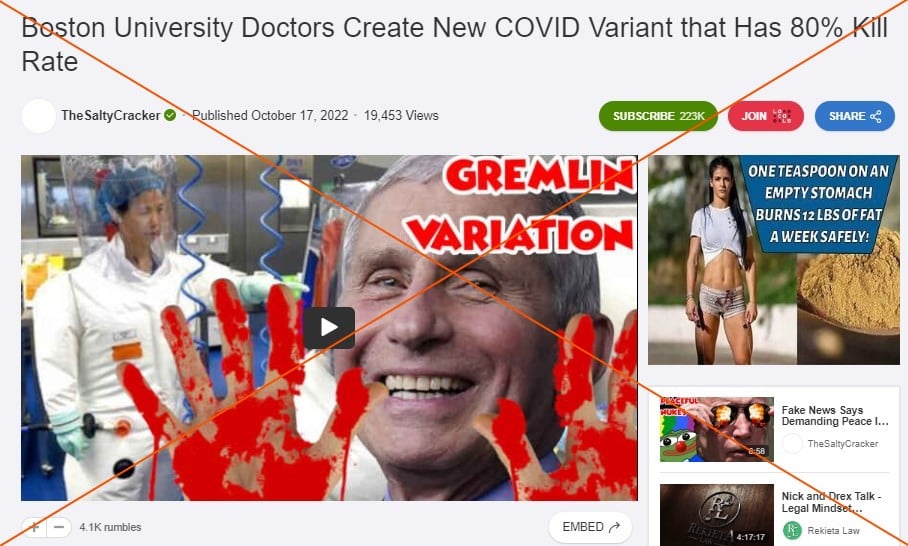[ad_1]
Social media posts have been shared tens of thousands of times, claiming that researchers at Boston University have created a new, more deadly type of coronavirus. But university scientists say this is a misinterpretation of their study, which was released before peer review — independent experts said France Press agency The search did not lead to a more dangerous virus.
“Catch Them Now: Boston University Doctors Create New COVID Variant With 80% Kill Rate—Funded By Dr. Fauci And The National Institutes Of Health,” reads the title of an article published on Oct. 17, 2022 from Analyst portala website that frequently spreads misleading health information.
The article has accumulated more than 2,500 shares on Facebook and has been featured in several videos, including one with over 19,000 views on Rumble and 11,400 views on Bitchute.
“US researchers have developed a new deadly strain of COVID in the lab — echoing the kind of experiments many fear started the pandemic,” the Rumble video claims, citing an Oct. 17 report. daily Mail.
The British paper quotes experts who question why the US should help fund gain-of-function research — or studies that can improve a pathogen’s “ability to cause disease,” according to the US Department of Health and Human Services.
Controversy over the study spread across Twitter, Facebook and Instagram.
“This is annoying!” says the tweet on Oct. 19. “The world has not yet fully recovered from the pandemic, however, scientists have created a more deadly strain of coronavirus. Why?”
Other articles repeating the claim have highlighted concerns about the still unresolved question about the origin of the COVID-19 pandemic. Reports found that SARS-CoV-2 jumped to humans from animals at a market in Wuhan, China, but the theory of possible laboratory leakage remains due to the lack of conclusive evidence.
Boston University (BU) sent a statement to AFP on October 18 saying that the Daily Mail and others had misinterpreted its research, which was released as prior publication.
“News reports have pulled one line from the paper’s abstract out of context,” Ronald Corley, director of the National Emerging Infectious Diseases Laboratory (NEIDL), said Oct. 17 on the university’s website.
France Press agency She reached out to the Daily Mail for comment, but a response was not forthcoming.
What did the researchers do?
The BU study focused on the transmissible Omicron variant of the coronavirus, with the goal of determining whether the spiky protein explains why it causes less severe disease.
The study focused on the Omicron spike protein because it carries a large number of mutations and appears to help the virus escape vaccine-induced immunity. The researchers took the gene for the Omicron(S) mutation and added it to the genome of the SARS-CoV-2 strain first seen in Washington state in early 2020, resulting in a new iteration of the virus.
The university said the study began in tissue culture and then moved to an animal model using mice engineered to be highly susceptible to the coronavirus. It has not been tested on people.
The researchers concluded that the spike protein was not the main factor in why Omicron is less lethal, saying that other viral proteins should be examined, according to the university.
“Identification of those proteins will lead to better diagnosis and disease management strategies,” NEIDL investigator Mohsin Saeed said in the October 17 article.
killing rate
The social media claims focus on the fact that while Omicron caused mild, non-fatal infections in mice, the virus created for the study killed 8 out of 10 of them.
BU said: “This figure of 80% is what has been held up by media reports, misrepresenting the study and its aims.”
The university said the virus created with a spike of omicron was no more deadly than SARS-CoV-2. In fact, the BU said in its statement that “this research made virus replication less dangerous.”
Craig Willen, a Yale University School of Medicine professor who has studied COVID-19, agrees.
Based on the initial research report, Willen said on Oct. 19 that the modified virus “was less lethal and less pathogenic in mice, and provided us with important information.”
He said the details show that the original, unmodified SARS-CoV-2 strain “kills 100 percent of mice” and that researchers have “made it less pathogenic.”
There was little reason to believe such an experiment would have serious results, according to Victor DiRita, chair of the department of microbiology and molecular genetics at Michigan State University.
“The investigators weren’t putting the protein into a completely different virus, they were asking precise questions using closely related strains,” he said. France Press agency In an email dated Oct. 19.
Arturo Casadevall, chair of the department of molecular microbiology and immunology at Johns Hopkins University, said on Oct. 19 that the research was “reasonable” and did not create a new, deadly strain.
“They took a piece of Omicron’s code that was already in circulation and put it on a virus that had already been tested on a lot of people,” he said.
Job acquisition
Job acquisition research is controversial. The US government paused funding for certain types of this work in 2014, though the restriction was lifted in 2017 and new protocols developed.
If the research includes “potential pandemic pathogens” — or bacteria and viruses that are likely to be highly transmissible — it requires increased oversight from the Department of Health and Human Services.
BU said its research should not be considered a “gain of function” because it “did not amplify the SARS-CoV-2 strain in Washington state or make it more dangerous.”
Some scientists have questioned that and said the researchers should have revealed more details.
Epidemiologist Marc Lipsitch of the Harvard School of Public Health said on Twitter that he considered the research a “gain of function” that should have been disclosed. However, his “fundamental” assessment was that “there is at least a reasonable risk-benefit argument in their favour, if done in a suitable bioenvironment.”
Boston University’s statement said the research “was reviewed and approved by the Institutional Biosafety Committee (IBC), which is made up of scientists as well as members of the local community.”
“The Boston Public Health Commission approved the research,” the university said.
“It appears that they maintained strict and appropriate Level 3 biosafety precautions,” said DiRita, who is also past president of the American Society for Microbiology.
However, in a statement emailed to France Press agency On Oct. 21, the US National Institute of Allergy and Infectious Diseases (NIAID), part of the National Institutes of Health (NIH), said it was “considering the matter to determine whether the research conducted was subject to the NIH Grant Policy Statement.”
The BU said on Oct. 18 that it had “fulfilled all required regulatory obligations and protocols,” adding that if there was evidence that research was gaining functionality, its protocols would have resulted in the project being “halted and reported.”
This type of research is common in virology, said Whelen of Yale University.
“This is research that’s been done for many years on many viruses,” Willen said. “The whole goal is to identify specific parts of the virus, such as how the virus evades the immune system.”
He said he did not consider the research a “gain-of-function” that would make the virus more deadly.
“They basically didn’t give the virus a new characteristic,” Willen said. “These are two very similar viruses.”
To make it more dangerous, he said, “you have to give him a new job without hurting another.”
[ad_2]
Source link



